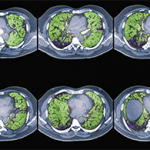 Undifferentiated connective tissue disease (UCTD) is a diagnosis given to patients who do not fulfill current classification criteria for named connective tissue diseases (CTD)—systemic lupus erythematosus (SLE), rheumatoid arthritis (RA), systemic sclerosis (SSc), or Sjögren’s disease—but who nonetheless have clinical signs and symptoms and serological evidence of autoimmune CTDs.
Undifferentiated connective tissue disease (UCTD) is a diagnosis given to patients who do not fulfill current classification criteria for named connective tissue diseases (CTD)—systemic lupus erythematosus (SLE), rheumatoid arthritis (RA), systemic sclerosis (SSc), or Sjögren’s disease—but who nonetheless have clinical signs and symptoms and serological evidence of autoimmune CTDs.
In 1980 LeRoy et al. were the first investigators to use the term UCTD, which they considered an early phase of a forthcoming CTD, the features of which would eventually fulfill classification criteria for a named diagnosis.1 For example, patients whose symptoms meet some criteria for SLE are often interchangeably described as having UCTD or incomplete SLE.2
Up to 60% of patients with UCTD, however, do not progress to a named CTD in the first three to five years after diagnosis; they are described as having stable UCTD.3-5
Many patients with UCTD have mild symptoms, but a subset may develop serious clinical manifestations or require hospitalization. Thus, risk stratification of patients based on progression of disease to defined CTDs or more serious manifestations may allow for earlier intervention and avoidance of unnecessary tests or therapy.
Believing that a consensus definition of UCTD will inform future studies and improve clinical care, we describe here the scope of the challenge posed by UCTD, discuss the opinions of involved stakeholders and review current research on its definition.
The Challenge
UCTD is heterogenous and variable in its clinical presentations, making it difficult to diagnose, manage and study. In 1999 Mosca et al. proposed these preliminary UCTD classification criteria:6
- Signs and symptoms suggestive of a named CTD, but not fulfilling classification criteria;
- Positive anti-nuclear antibody test; and
- Disease duration of at least three years.
Currently, 44 years after LeRoy’s first description and 25 years after Mosca’s proposal, neither official criteria for nor consensus guidelines regarding the diagnosis and management of UCTD exist.4 Instead, doctors diagnose UCTD retrospectively, when a patient’s illness has not evolved to a named CTD after three years.7
Classification criteria for named CTDs, which can include or exclude a UCTD diagnosis, are periodically revised. For example, a patient is diagnosed with UCTD because she does not fit 1997 SLE criteria. Because SLE criteria were updated in 2019, with no change in her course, she is now said to have SLE. The opposite is also true. With the new criteria, as many as 50% of patients diagnosed with a named CTD, such as SLE, may now be diagnosed as having UCTD.8

